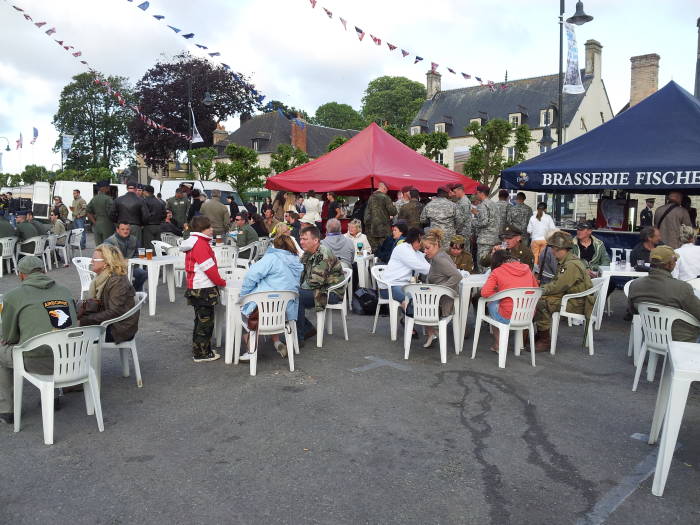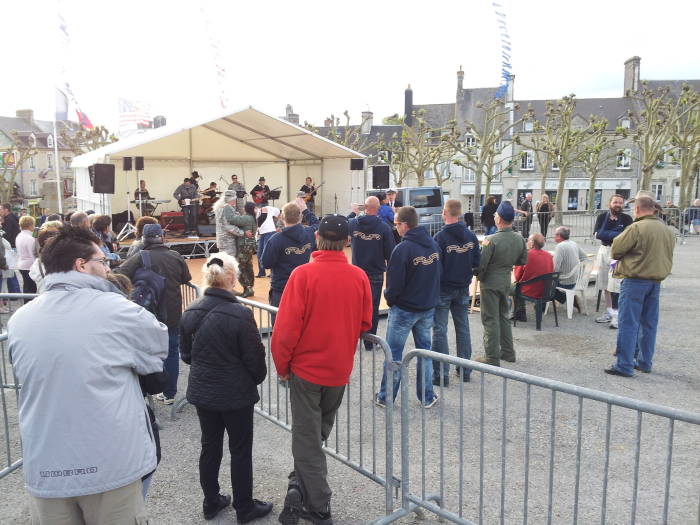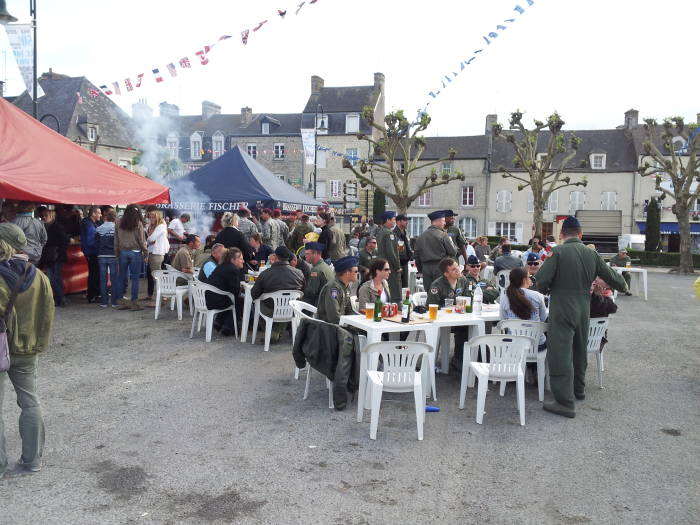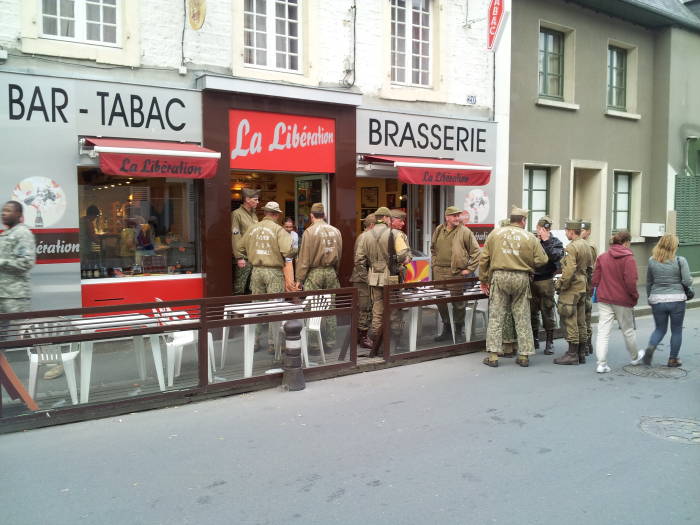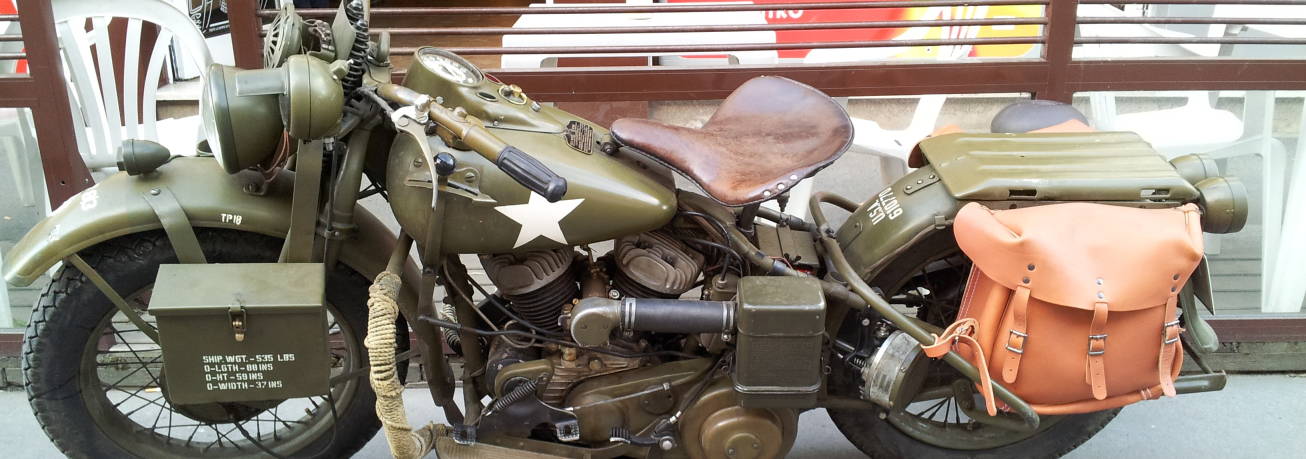
Normandy — D-Day — 6 June 1944
Reenactors
Reenactors
So far we have been on a detailed visit to Normandy, visiting the landing beaches and battlefields of the D-Day landings on June 6, 1944. The pages up to here have followed that trip in order. That visit was in September, when it was easy to find places to stay and travel from site to site. Here are some pictures from a later visit to Normandy. This was on June 3, just three days before the enormous national observation of the anniversary.
June 6th is a national holiday in France. The President visits the landing beaches and makes national addresses. Schools and businesses are closed if the 6th falls on a week day.
We happened to be there on a Sunday, which made for even larger crowds of visitors. That meant that it took longer to get around and find places to park the car, but on the plus side there were some special things going on.
There are many French and Belgian history enthusiasts with a deep interest in and knowledge of the wartime history. They pay tribute to the brave invaders and underground fighters through detailed reenactment, meticulously recreating uniforms, personal equipment, and (disabled) weapons.
Pegasus Bridge
The men you see here are at Pegasus Bridge, portraying the British troops who arrived around midnight by glider and parachute to capture and hold the bridge. This prevented the Germans from using it for an armored counterattack, while preserving it for later use by the Allies to break out of the landing beaches.
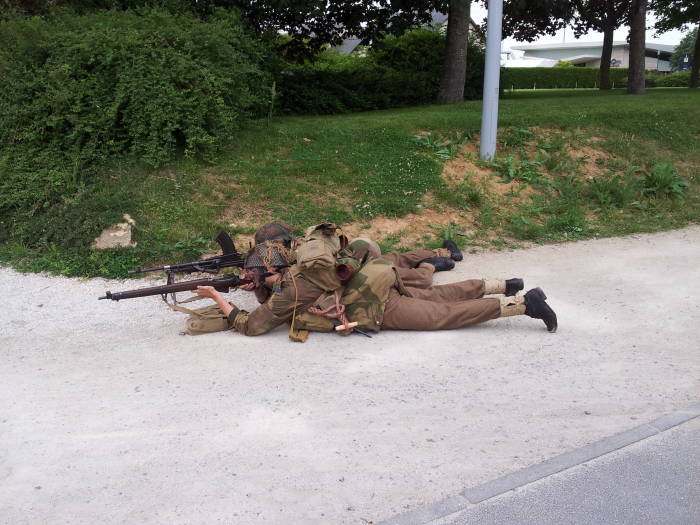
I think the nearer man has a Lee-Enfield .303 bolt-action rifle. The SMLE or Short Magazine Lee-Enfield was developed in 1907, it is still in official use by reserve forces and police in many British Commonwealth nations. It is the main rifle issued to the Canadian Rangers, and is widely used by reserve military forces and police units in India. The only older design still in official use is the Russian Mosin-Nagant, a design dating back to 1891 with some variations adopted more recently.
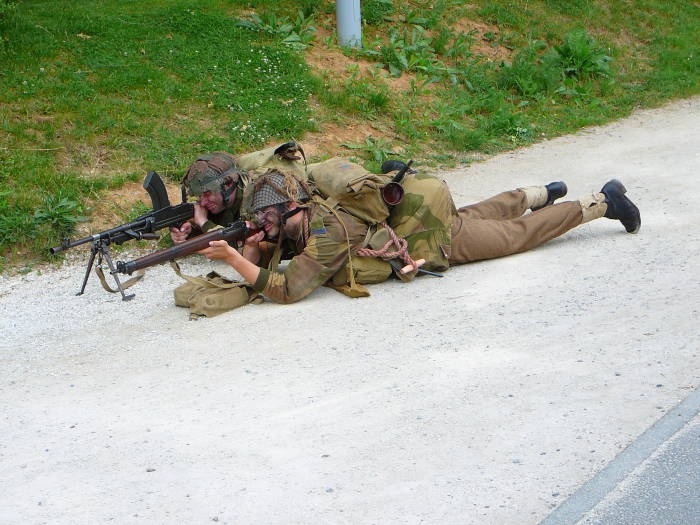
The other appears to be a Bren LMG or light machine gun, also firing the .303 British round and designed in 1935. In variations collectively known as the L4 (L4A1, L4A2, etc), it has been used until recently by many Commonwealth countries and is still used by the Jamaica Combined Cadet Force.
A man in a maroon beret portraying an officer evaluates their reenactment portrayal.
Or, he portrays an officer evaluating his men.
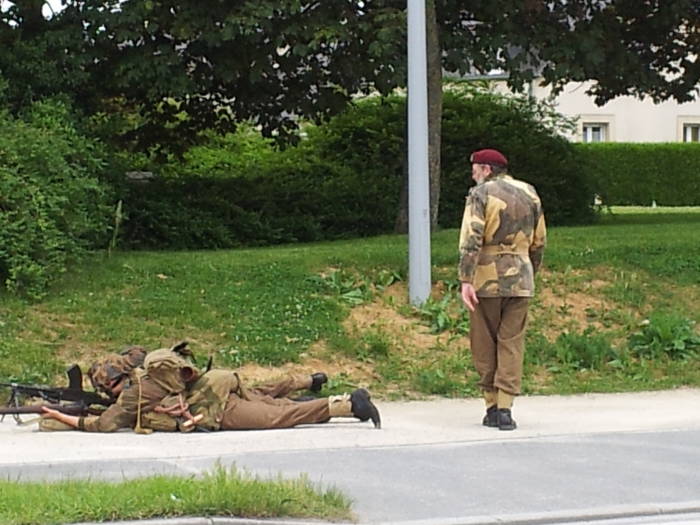
Accurate and detailed reenactment can get a little confusing...
Angoville-au-Plain
These men appear to be U.S. personnel in 1940s uniforms with 1940s equipment, but they are French reenactors. Being in Normandy around the time of the annual commemoration of the landings can be rather disorienting. It's as if you have stepping onto a movie set, or even back in time.
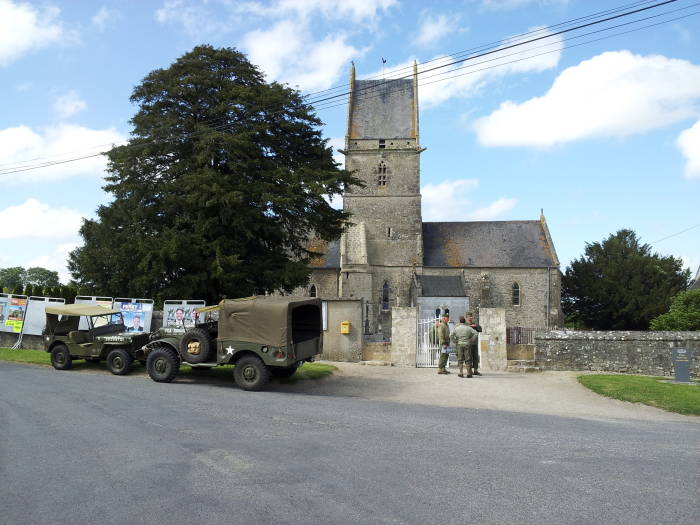
This is the church at Angoville-au-Plain, famous for becoming a refuge for both civilian and military wounded on D-Day. Two medics from the U.S. 101st Airborne Division provided lifesaving care to 80 combatants, an act commemorated by a memorial marker here. Blood stains remain on the pews in the sanctuary.

Sainte-Marie-du-Mont
The town of Sainte-Marie-du-Mont was largely impassible on June 3rd. Most of the central square and two of the four main roads leading in and out of the town were completely blocked.
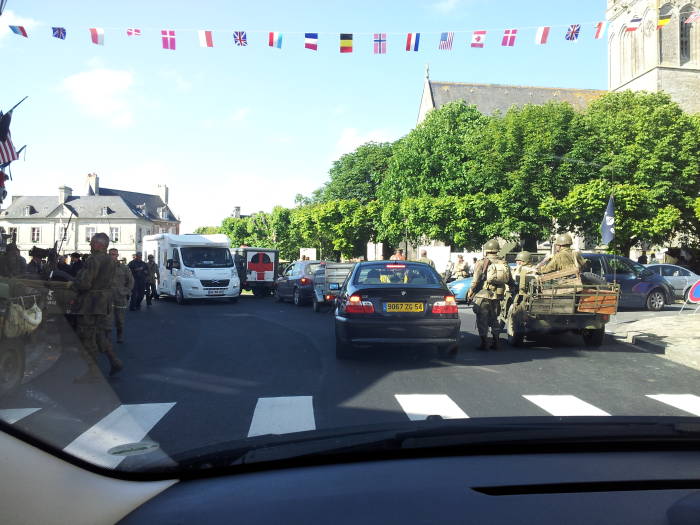
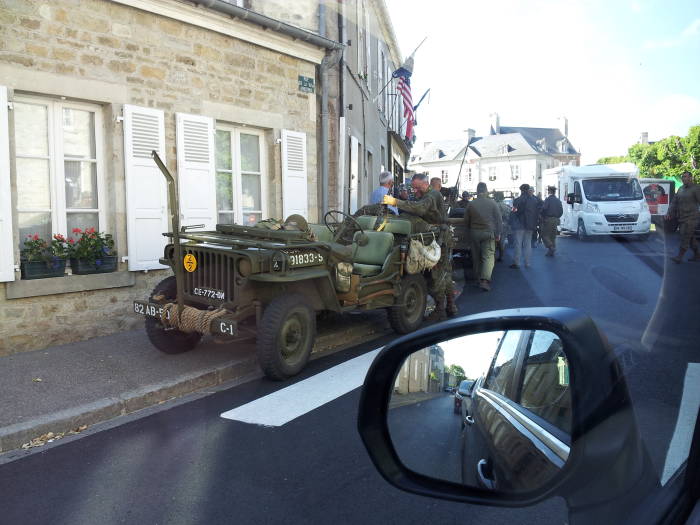
Reenactors' light vehicles, jeeps and small trucks, lined the square. One reenactor brought his Churchillian bulldog.

A member of the French Underground appears, in black leather jacket and beret with a Sten gun slung over his shoulder.
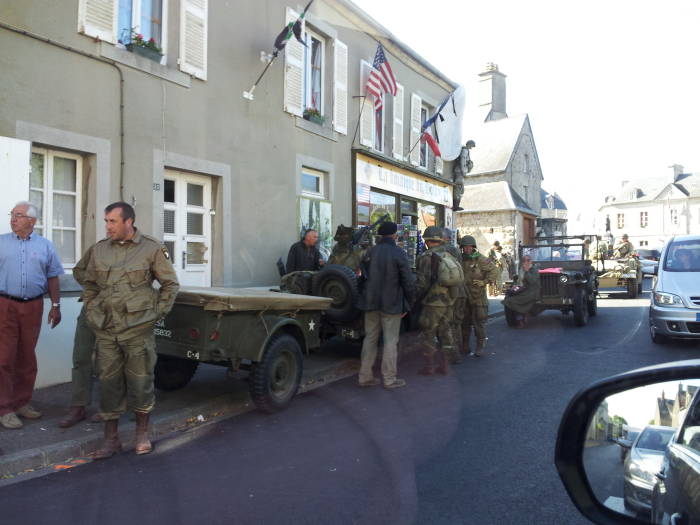
The Sten gun was a family of 9mm submachine guns with a simple design. Its name is an acronym for its two primary designers, Major Reginald V. Shepherd and Harold Turpin, plus EN for Enfield, the initial manufacturer. The Sten design used stamped metal components and only minimal machining and welding, so they could be produced in small workshops. The most basic model required just five man-hours of work.

It's a very basic design, blowback-operated with a fixed firing pin on the bolt. The bolt remains to the rear when the weapon is cocked and ready to fire. Pulling the trigger allows the bolt to travel forward, stripping a round from the magazine, chambering it, and firing the round. This mode of operation made it prone to accidental discharges, the used of a pistol round limited it effective range to about 100 meters. But it was a very useful weapon for airborne troops as well as reistance operators like the French Underground.
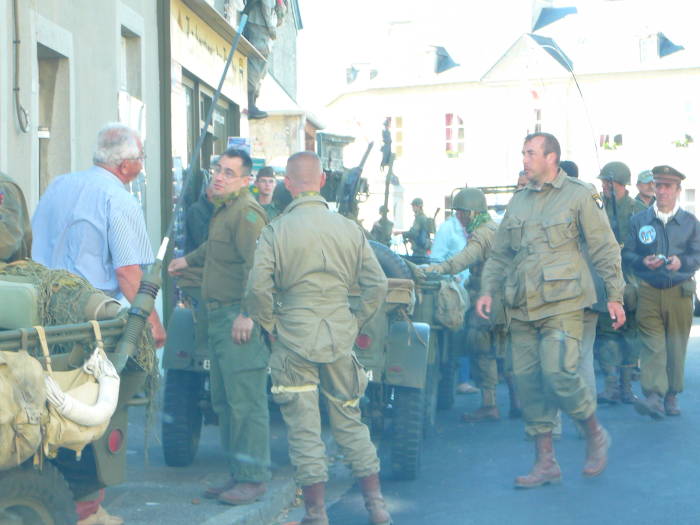
This reenactor's insignia identifies his character as a member of the U.S. 82nd Airborne Division.
The 82nd and 101st Airborne Divisions jumped into the Cotentin Peninsula around Sainte-Mère-Église.
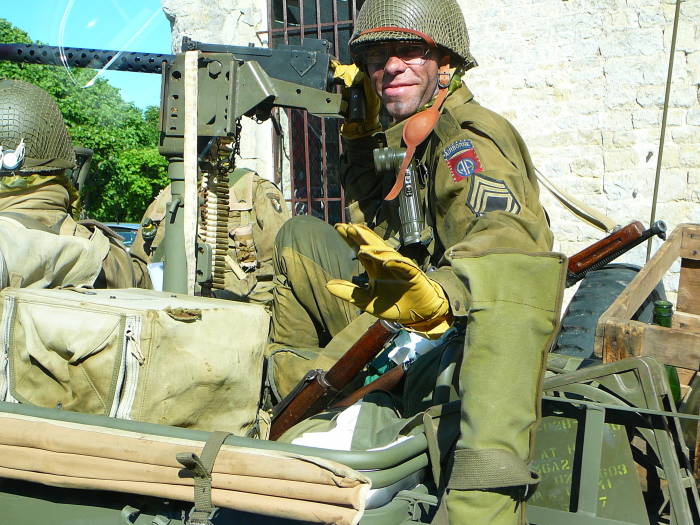
The 101st Airborne Division's objectives were to secure the four causeway exits from Utah Beach, to capture nearby buildings at Mésières thought to be the command post and barracks of the artillery battery, and to capture or destroy various critical points along the Douve River.
The 82nd Airborne Division jumped from nearly 370 C-47 troop carrier aircraft in Mission Boston. Their objectives were to capture the town of Sainte-Mère-Église and block the approaches into the town, seize causeways and bridges over the Merderet River, destroy a highway bridge over the Douve River at Pont l'Abbé, and secure the area west or inland from Sainte-Mère-Église.
The two Airborne divisions would then link up between Utah Beach and Sainte-Mère-Église, having disrupted German communications and movements.
Sainte-Mère-Église
Traffic, visitors, and reenactors got thicker and thicker as we approached Sainte-Mère-Église. The streets were blocked several blocks from the central square, parking areas were available there.
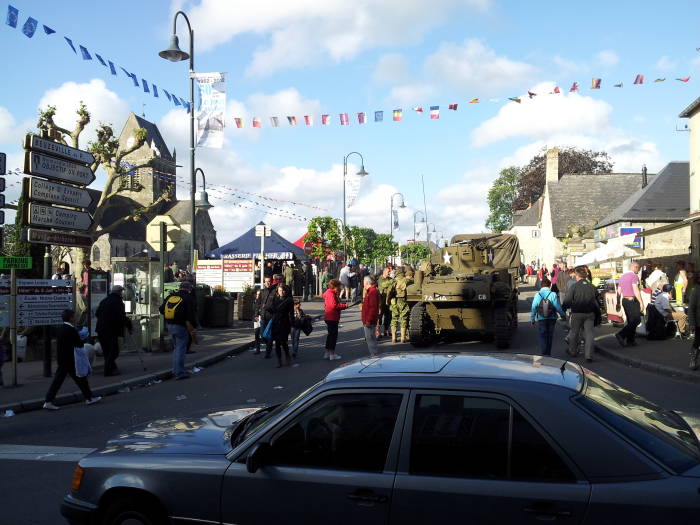
Armored vehicles and large trucks were parked all around the central square. A group of enthusiasts based in Brittany restores armored vehicles. Brittany is just west of Normandy, but it would still be an enormous operation to bring a tank to Sainte-Mère-Église!
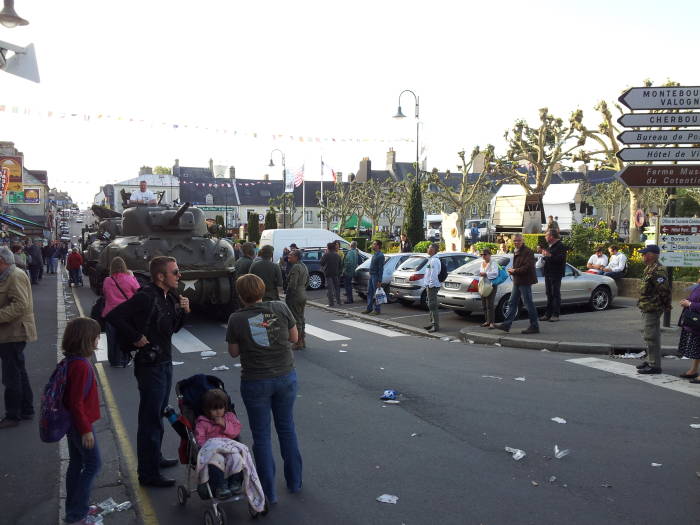
Actual U.S., Dutch, and Belgian forces join the French and Belgian reenactors on the square.


Hey, that mobile phone isn't period!
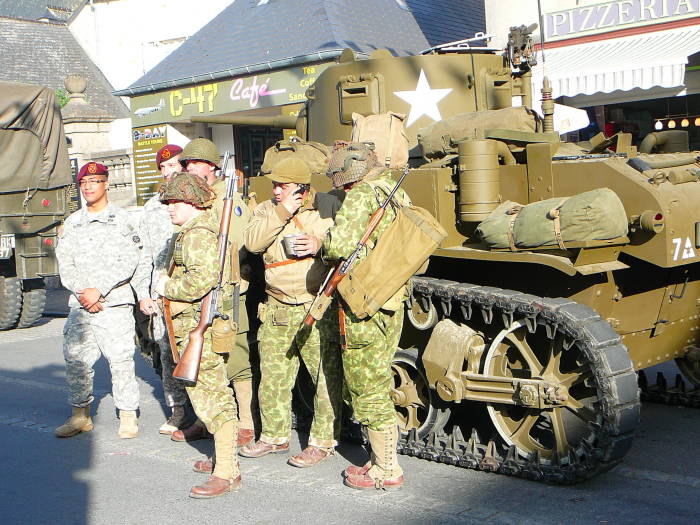



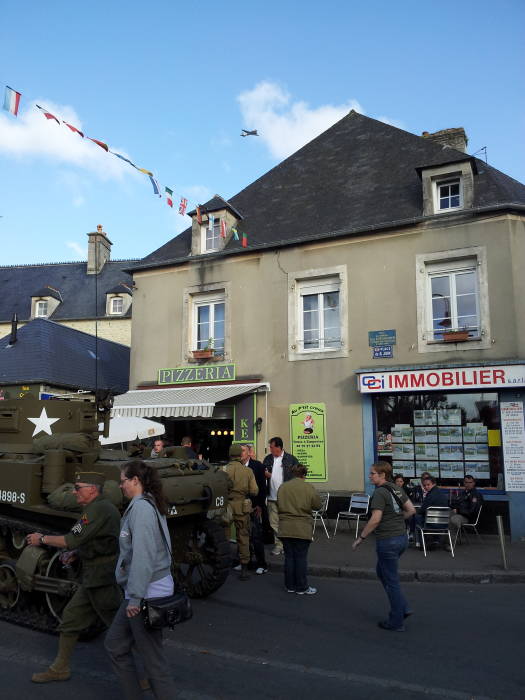

In the pictures immediately above and below you see a C-47 flying over Sainte-Mère-Église. The current airborne troops from the U.S. and other NATO nations jumped into the surrounding area, where the U.S. 82nd and 101st Airborne Divisions had jumped the night of 5-6 June 1944.
The Douglas C-47 was the military version of the DC-3 airliner. There were several versions, designated collectively as the Skytrain by the U.S. Army Air Force, the R4D Skytrain by the U.S. Navy and Marine Corps, and the Dakota by the British Royal Air Force. A specialized paratroop variant designated the C-53 Skytrooper was used to tow gliders and drop paratroops.
The AC-47 Spooky, commonly called Puff, the Magic Dragon, was a gunship used in Vietnam. It had three 7.62mm General Electric miniguns firing through ports of the left side of the aircraft, providing devastating close air support for ground troops. It poured suppressing fire into an elliptical area about 48 meters in diameter, placing a round every 2.2 meters in a 3-second burst. The AC-47 was eventually replaced with the larger AC-130H/U/W.
Colombia started operating very similar retrofitted AC-47s in 2006 in counter-insurgency operatings. El Salvador still operates some supplied by the U.S. in 1984-1985.
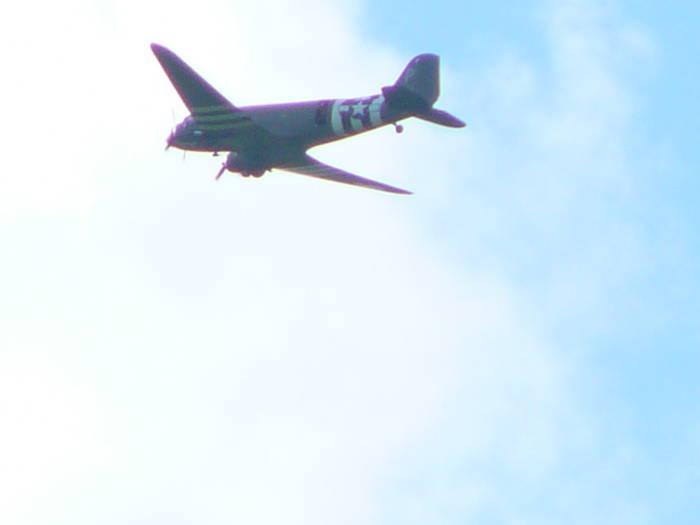
We got dinner in the brasserie La Libération just off the square in Sainte-Mère-Église. A number of Belgian reenactors were also getting dinner.

One of the Belgians had arrived on his meticulously rebuilt motorcycle, a vintage U.S. military Harley-Davidson. Notice the Belgian license plate.
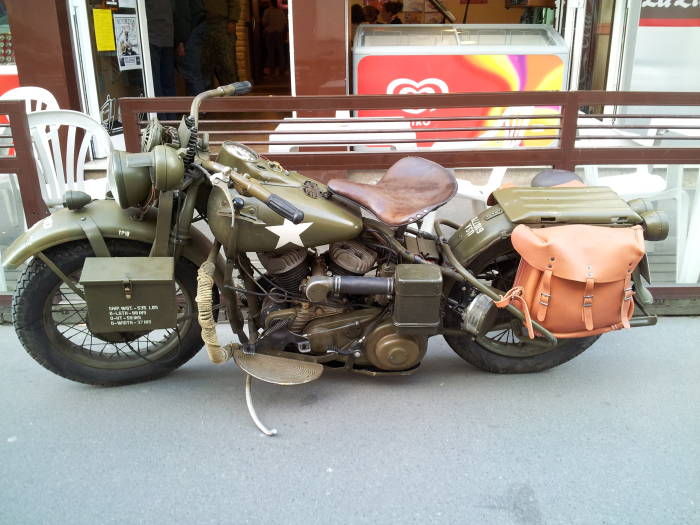

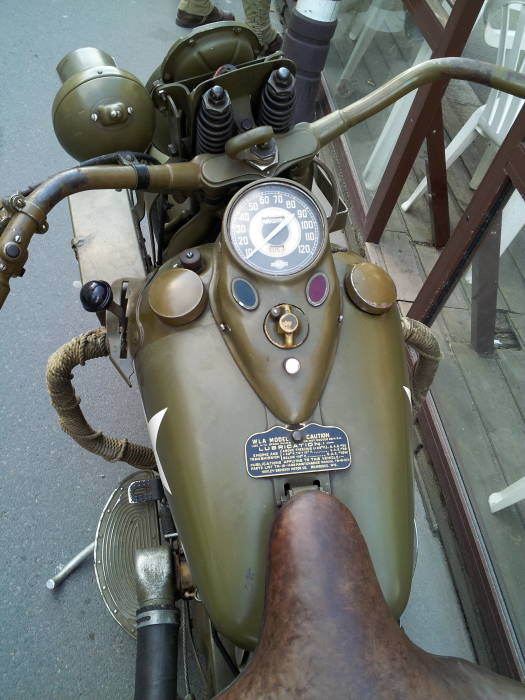
The maintenance plate on the gas tank explains what to do to with this Harley-Davidson WLA model:
| W | = | Harley-Davidson assigned letter designs to model families. The W series had a 740 cc flathead motor. Its side-valve design traded some efficiency for reliability. The rear wheel had no suspension, leading to the nickname "Hard Tail". |
| L | = | High compression, although this is a relative thing. Higher than contemporary designs, but relatively low compression by modern standards. |
| A | = | (U.S.) Army, "C" was a slightly different model for the Canadian Army. |
Use authentic Harley-Davidson spark plugs.
Do not exceed a speed of 65 miles per hour.
Lubricate it properly:
- S.A.E. #50 oil at temperatures above 32° F.
- S.A.E. #30 oil at temperatures of 10-32° F.
- S.A.E. #10W oil below 10° F.
Use the proper manuals, which you can find today through Google:
Harley-Davidson started manufacturing the WLA in 1940, with over 90,000 produced during the war. The majority of these remaining in the U.S. and Europe were "civilianized", modified to choppers and similar variants.
Over 30,000 WLAs were sold to the Soviet Union under the Lend-Lease program, later stored or transferred to private ownership. Russia and other former Soviet countries are now the main source of complete WLAs and parts.

The WLA is very similar to the WL civilian model. Changes included:
- The finish was olive drab or black paint, with normally chrome-plated or nickel-plated parts instead parkerized or blued.
- The fenders were modified to reduce mud buildup.
- The crankcase breather was modified to reduce water intake when fording streams.
- An oil bath air cleaner was added to handle the increased dust of largely off-road use.
- Blackout covers were added to the lights.
- Cargo and carrying accessories were added, like an ammunition box, scabbard for a Thompson submachine gun, and a heavy rack for radio equipment.
The U.S. and NATO forces along with the French and Belgian reenactors enjoyed a musical program in the central square in Sainte-Mère-Église.

